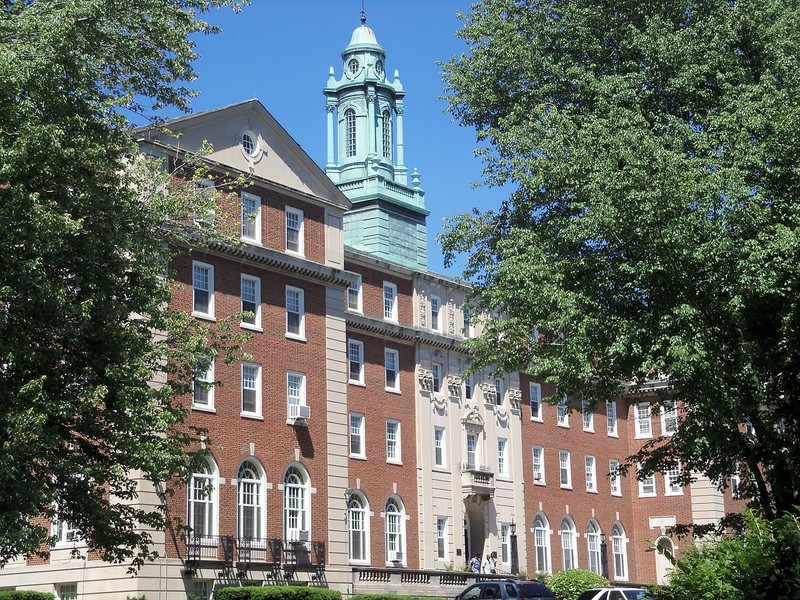St. Joseph's Seminary
Introduction
Text-to-speech Audio
The former St. Joseph's Seminary is one of several Catholic institutions in this Washington neighborhood, which is known as "Little Rome." It was built in 1930 by the Society of Saint Joseph of the Sacred Heart, which was founded in 1893 to serve the African Americans although its roots in America date earlier to 1871. The Society's priests and brothers are known as "Josephites" and many of them now come from Nigeria. The building operated as a major seminary until 1971 and is now a residence for Josephite seminarians attending the nearby Catholic University and retired Josephites. It also houses the Josephite Pastoral Center, which offers African American-oriented educational materials, conferences, workshops, and pastoral programs for parishes, institutions, and diocese. The building, which was designed by the firm Maginnis & Walsh, is also significant for its Colonial Revival/Neo-Georgian Revival architecture. It was added to the National Register of Historic Places in 2022.
Images
St. Joseph's Seminary was built in 1930 by the Society of Saint Joseph of the Sacred Heart, which was established in 1893 to administer to African Americans. It closed in 1970 and is now a residence for seminarians and retired Josephites.

Backstory and Context
Text-to-speech Audio
The Society's mission to serve African Americans originated after the Civil War when there was a great need to educate the thousands of former enslaved people in Washington D.C. In 1869, the U.S. Council of Catholic Bishops called on the Council Fathers to establish African American schools and missions in the Baltimore diocese, which included Washington D.C. until 1939. In response, the Council Fathers sent a letter to Father Herbert Vaughn, the superior general of the Saint Joseph's Society for Foreign Missions, which was located in Mill Hill, London, requesting he establish a mission in Baltimore. After receiving permission in 1870, Vaughn and other English priests arrived in 1871 and founded the mission and named its missionaries "Josephites," who studied in Mill Hill and then returned to America.
By the early 1890s, it had become too difficult for the Foreign Missions to manage its work in Baltimore. As a result, in 1893 the cardinal of the Archdiocese of Baltimore allowed the Josephites to become an independent organization. One of the founders of the Society was Father Charles Uncles (1859-1933), who was the first African American priest in the United States. The Josephites were first house in a former hotel at St. Mary's Street and Pennsylvania Avenue but moved to a larger, adjacent building in 1893. They stayed there until the Seminary was built in 1930. In the early 1890s, this area of the city was mostly rural and took several decades to develop. However, many other Catholic churches, institutions, and organizations had already been established here, including the Catholic University of America.
Although the Society was established to serve African Americans, internal and external racist attitudes prevented it from accepting African American seminarians for the next few decades. Only three became priests between 1893-1907. The director of the Seminary during that time, Father John R. Slattery, was so frustrated with the prevalent racism and criticism he received from training them that he left the priesthood and the Church. The Josephites then officially closed the seminary to African Americans except for a few mixed-race candidates. Other Catholic seminaries did the same. St. Joseph's didn't start accepting African American seminarians until the 1940s. The seminary function at St. Joseph's ended in 1970 and it became a residence at that time. It appears Nigerian seminarians started arriving in the 1980s.
Father Uncles, who was studied to become a priest in England and at St. Mary's Seminary in Baltimore, was barred from serving as a pastor in Baltimore. He was allowed to teach at Epiphany Apostolic College, which was founded as minor Josephite seminary founded in Baltimore in 1889; it was later moved to New Windsor, New York. Uncles died there in 1933.
Sources
"Country’s first Black priest started in Baltimore." The Josephites. Accessed November 23, 2022. https://www.josephites.org/feature-stories/countrys-first-Black-priest-started-in-baltimore.
Kelly, Jacques. "First African-American priest gets his due." The Baltimore Sun. December 2, 2010. https://www.baltimoresun.com/maryland/bs-xpm-2010-12-03-bs-md-kelly-column-uncles-20101203-story.html.
Mellon, Jonathan. "St. Joseph's Seminary." National Park Service - National Register of Historic Places Nomination Form. September 28, 2022. https://planning.dc.gov/sites/default/files/dc/sites/op/publication/attachments/St%20Joseph%20Seminary%20nom%20complete.pdf.
Ochs, Stephen J. "Desegregating the altar : the Josephites and the struggle for Black priests, 1871-1960." Baton Rouge, LA: Louisiana State University, 1993. https://www.worldcat.org/title/28646434.
"Our History." Josephite Pastoral Center. Accessed November 24, 2022. https://josephitepastoralcenter.org/who-we-are/our-history.
"St. Joseph's Seminary." D.C. Historic Sites. Accessed November 23, 2022. https://historicsites.dcpreservation.org/items/show/1151.
Willis, Laurie. "Nigerian seminary to provide recruits for U.S. priesthood; Order sees need to serve Blacks." The Baltimore Sun. May 3, 2000. https://www.baltimoresun.com/news/bs-xpm-2000-05-04-0005040014-story.html.
Wikimedia Commons: https://commons.wikimedia.org/wiki/File:St._Joseph_Seminary_DC.JPG
